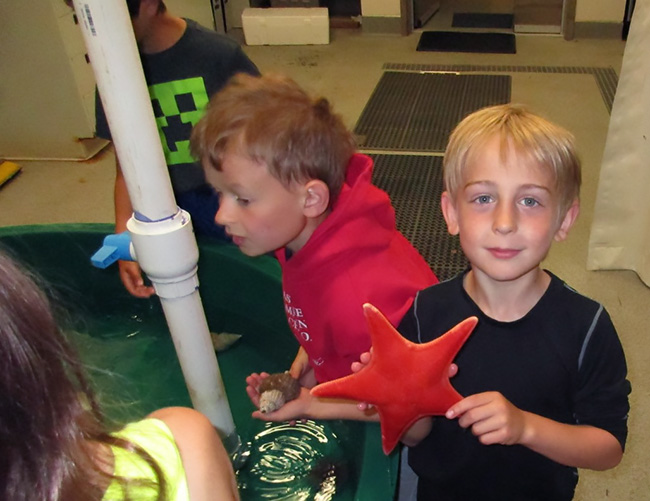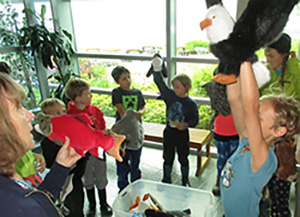
AFSC News
July 27, 2016
Auke Bay Laboratories welcomes students to inspire future scientists
By Maggie Mooney-Seus
 |
| Gordy Warrenchuk holds a sea star and learns about other intertidal animals Photo: NOAA Fisheries |
Summer Learning
For decades, the Alaska Fisheries Science Center?s Auke Bay Laboratories at the Ted Stevens Marine Research Institute in Juneau, Alaska has welcomed students of all ages to various science education programs throughout the summer. This summer is no exception.
The kick-off event was the annual Sun to Sea Science Camp for middle school students in early June. More recently, Outreach Coordinator Bonita Nelson hosted 40 students from Angoon, Hoonah, Klukwan, Prince of Wales Island, Kake and Juneau as part a summer program organized by the Sealaska Heritage Institute and two groups of students from the Discovery Southeast Nature Camp.
?We?re thrilled to have the students here,? said Auke Bay Laboratories Director Phil Mundy. ?Our goal is to get kids excited about science, to engage them early and peak their curiosity about the natural world and the important research being done to understand and protect it.?
The Sealaska Heritage Institute visit is part of the Institute?s Middle School Math and Culture Academy. The students learned about our research and participated in hands-on activities visa via the touch tank. They also took a tour of the biology, chemistry, necropsy and wet labs. This year?s camp theme--"Exploring Fisheries."
Also this month, two groups of students from the Discovery Southeast visited the Auke Bay Laboratories. The focus of the first visit was ?salmon,? part of a weeklong day camp on Alaska?s prized fish. The second group of elementary-aged students spent a day at the lab engaged in activities such as fish identification, exploring intertidal animals through the touch tank, and learning about salmon life history and migration using puppets.
 |
| Students learn about salmon life history and migration using puppets Photo: NOAA Fisheries |
Highlights of Sun to Sea Science Camp
Twelve students participated in this annual event, which included field trips, laboratory exercises and two half-day trips on the research vessel Sashin, where students were introduced to our research programs, information on the local weather and the marine environment.
The field trips included visiting the Juneau National Weather Service office, beach seining and intertidal exploration at Sunshine Cove and water testing at Amalga Harbor. Students learned about the importance of currents in early salmon ocean and smelt migrations in Auke Bay, Fritz Cove and Mendenhall. They also observed marine mammals and seabirds in their natural habitat.
In the laboratory, they identified plankton using dissecting microscopes, built model wetlands in a cup from materials collected near the harbor; simulated oil spills in a pie pan; examined invertebrate anatomy by dissecting sea stars, clams and cockles; watched a shark dissection, and conducted simple water chemistry tests and shell dissections to learn more about Paralytic Shellfish Poisoning.
They captured their camp experience by printing T-shirts using fabric paint, silicon fish and stamps, making entries in a journal and producing I-movies, which they previewed for their parents as part of the camp wrap-up.
Sun to Sea Marine Science Camp was co-sponsored by the Juneau Economic Development Council-STEM AK program, the National Weather Service (Juneau) and Southeast Alaska Independent Living (SAIL/ORCA) in Juneau.
Questions? Please contact Marjorie Mooney-Seus,
206-526-4348 (office), 774-392-4865 (cell)
|